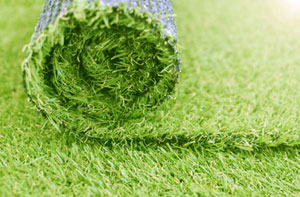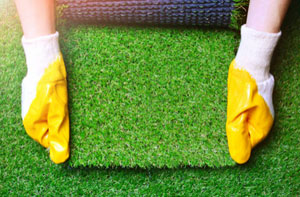Artificial Grass Nailsea Somerset: When reviewing landscaping options for your garden in Nailsea you may be thinking about artificial grass as an option, and considering its benefits like long-lasting durability, low maintenance, and its ability to maintain its appearance regardless of weather conditions, this could be an excellent idea. It is also eco-friendly, because it reduces the requirement for water and fertiliser. However, it is important that you weigh the upfront cost of installation against the long-term cost savings, and the particular needs of your property before making a decision. Finding out about different styles and makes of artificial grass can also help you in making an informed choice.
What is Artificial Grass? - Artificial grass, also often called synthetic turf, is a surface that's made of plastic fibres designed to look like genuine grass. It's commonly used as a substitute for genuine grass in areas where natural grass is difficult to maintain, such as sports fields, commercial landscaping and domestic lawns. Artificial grass is made from synthetic materials, like nylon, polypropylene and polyethylene, which are designed to look and feel like normal grass. It's usually installed over a prepared base, such as gravel, and secured in position with edging materials, such as plastic, concrete, natural stone or aluminium. Artificial grass doesn't require much maintenance and provides a consistent alternative to normal grass.

Who Installs Artificial Grass? - Artificial grass is usually installed by professional artificial grass installers or landscape contractors. These professionals have the experience, knowledge and skills required to install artificial grass correctly and to make sure the finished product meets the particular requirements of the job.
When choosing an artificial grass installer in Nailsea, it's crucial to look for a company with a proven track record of customer satisfaction and high quality installations. You can look for reviews online and ask for references to get a good idea of the company's level of expertise and reputation. It's also a good idea to get multiple quotes from different installers to compare prices and ensure that you are getting the best possible deal.
Overall, hiring a reliable artificial grass installer in Nailsea should ensure that your artificial grass installation is done properly, efficiently, and to the standards you desire.
What Are the Advantages? - One of the main advantages of artificial grass is its low maintenance properties. Unlike authentic grass, it doesn't need to be watered, mowed or fertilized. This makes it a popular choice for parks, sports fields and commercial landscaping, where the upkeep of a natural grass area can be time-consuming and costly.
Another advantage of artificial grass is its versatility. It can be used in a range of weather conditions and climates, and it is also suitable for use in locations where natural grass is hard to grow, for instance on slopes or in desert regions.
Artificial grass has also become popular in residential landscaping, where it's often used to create a low-maintenance lawn or landscaping features such as putting greens, play areas and patios. Even so, it's important to consider the impact of artificial grass on the environment, because it is not biodegradable and can contribute to microplastics pollution.

Does it Need Underlay? - In some scenarios, indeed, artificial grass may need an underlay. An underlay is a layer of material that is placed under the artificial grass to provide a level and stable base for the grass to sit on. The reason for the underlay is to make certain that the artificial grass is installed correctly and to provide a cushioned base for the grass fibres to rest on. The employment of an underlay can also help improve the overall performance of the artificial grass, by providing a sturdy surface that lowers the risk of grass fibres becoming damaged or displaced over time.
Whether or not an underlay is necessary depends on the specific requirements of the artificial grass installations and the sort of surface the artificial grass is being installed on. For example, if the surface has a significant slope or is uneven, an underlay could be necessary to provide a stable base for the artificial grass. In other circumstances, the surface might be suitable for installation without an underlay. It is essential to consult with a professional artificial grass installer to determine the ideal solution for your particular needs.
What Edging is Required for Artificial Grass? - Edging is used to secure and contain the artificial grass in place. Edging options for artificial grass include:
- Wood Edging: One of the most widespread types of edging that is used for artificial grass is timber, mainly because it is a cost-effective solution and is easy to cut and install.
- Concrete Edging: Concrete edging is the most cost-effective and common option. It is poured around the boundary of the artificial grass to create a stable and permanent edge.
- Plastic Edging: Plastic edging is a flexible and lightweight option that is easy to install. It's often used to create a curved edge for artificial grass installations.
- Natural Stone Edging: Stone edging is a decorative option that can enhance the overall appearance of the artificial grass installation.
- Aluminum Edging: Aluminum edging is a heavy-duty option that's long-lasting and durable. It's often used for commercial artificial grass installations.
The form of edging employed will be determined by the particular requirements of the artificial grass installation, including the alocated budget, the surface area and the desired aesthetic.
Why is Artificial Grass Popular for Sports Surfaces?
Artificial grass is popular for use as a sports surface for a number of reasons, including:
- Reduced Water Usage: Man-made turf doesn't need to be watered, which reduces water consumption and makes it an environmentally conscious choice for sports complexes.
- Improved Performance: Man-made grass is designed to mimic the performance characteristics of natural grass, delivering a surface that is ideal for sports and other physical activities.
- Reduced Risk of Injury: Artificial turf delivers a uniform and stable playing area, which lowers the risk of injuries for sports players. It also provides better shock absorption, thereby minimizing the risk of impact injuries.
- All-Weather Use: Imitation grass can be used in any weather and is a great choice for outdoor sports facilities that require a durable playing surface throughout the year.
- Durability: Artificial grass is made from durable materials that are resistant to wear and tear, fading, and pests, so it can last for many years with proper installation and maintenance.
- Consistent Playing Conditions: A constant playing surface is guaranteed by artificial grass, regardless of weather conditions or usage frequency, making it a safe and reliable choice for sports fields.
- Versatility: Man-made turf can be utilized for different sports, such as soccer, football, baseball, and golf, making it an ideal choice for multi-sport complexes.
- Low Maintenance: Artificial turf necessitates minimal maintenance, such as occasional brushing and cleaning, decreasing the requirement for costly upkeep and allowing sports facilities to focus on other significant aspects of their operations.
- Long Lifespan: Fake grass can last up to 20 years with proper maintenance, which makes it a financially savvy option compared to natural grass that needs to be replaced regularly.
- Improved Aesthetics: Fake grass delivers a tidy and refined aesthetic and can be tailored to meet particular visual demands, making it an appealing option for sports complexes.
- Environmental Impact: Natural grass necessitates the use of copious amounts of water, fertilizers, and pesticides to remain healthy, which can negatively impact the environment. Artificial grass, however, is a more environmentally friendly alternative that doesn't require any of these resources.
The combination of durability, minimal upkeep, consistent playing conditions, injury prevention, longevity, and sustainability make artificial grass a popular choice for sports surfaces.
The Different Types of Artificial Grass
- Polypropylene
- Long Pile
- Short Pile
- Polyethylene
- Medium Pile
- Nylon
Winter Care
With its minimal upkeep requirements, artificial grass is a popular choice among business and home owners alike. Winter care for artificial grass is crucial for maintaining its lifespan and appearance. To prevent mould growth or damage during the winter months, it is important to clear any debris that collects on the surface of artificial grass, such as leaves or branches, which can block drainage and cause water to accumulate.
In areas with heavy snowfall, it is recommended to gently brush off the snow to prevent any excessive weight on the turf. To prevent fibre damage and discolouration, chemicals or de-icing salts should be avoided on artificial grass.
Keeping your artificial grass in good condition during the winter months means maintaining a cleaning routine. To keep your artificial grass looking fresh and healthy, it is important to quickly clean up any pet waste or spills and use a soft brush to maintain the grass blades. In summation, for the artificial grass to maintain its appearance and function during winter, regular cleaning and minimal intervention are crucial.
Coming Next:
Artificial grass cleaning - article 217.
TOP - Artificial Grass Installer Nailsea - Garden Clearances
Synthetic Turf Installers Nailsea - Artificial Grass Installer Nailsea - Artificial Grass Companies Nailsea - Fully Qualified Artificial Grass Installers Nailsea - Artificial Turf Nailsea - Artificial Grass Installation Services Nailsea - Artificial Grass Near Me - Residential Artificial Grass Installer Nailsea - Artificial Grass Installers Nailsea


